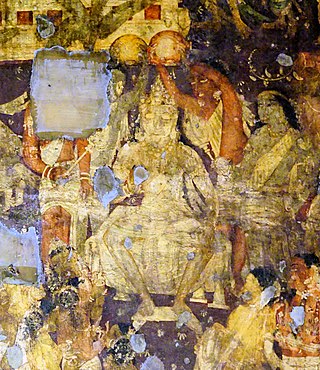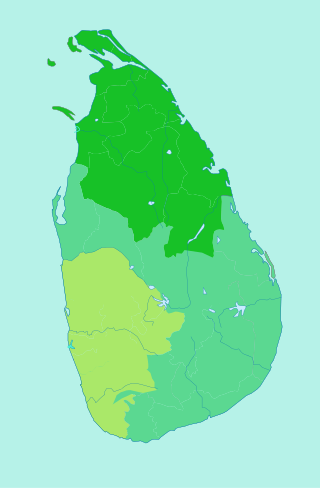
Sinhalese people are an Indo-Aryan ethnolinguistic group native to the island of Sri Lanka. They were historically known as Hela people. They constitute about 75% of the Sri Lankan population and number more than 16.2 million. The Sinhalese identity is based on language, cultural heritage and nationality. The Sinhalese people speak Sinhala, an insular Indo-Aryan language, and are predominantly Theravada Buddhists, although a minority of Sinhalese follow branches of Christianity and other religions. Since 1815, they were broadly divided into two respective groups: The 'Up-country Sinhalese' in the central mountainous regions, and the 'Low-country Sinhalese' in the coastal regions; although both groups speak the same language, they are distinguished as they observe different cultural customs.

Anuradhapura is a major city located in north central plain of Sri Lanka. It is the capital city of North Central Province, Sri Lanka and the capital of Anuradhapura District. The city lies 205 km (127 mi) north of the current capital of Colombo in the North Central Province, on the banks of the historic Malvathu River. The city is now a World Heritage Site famous for its well-preserved ruins of the ancient Sinhalese civilization.

According to the Mahāvaṃsa chronicle, Prince Vijaya was the first ruler. Legends and records from both Indian and Sri Lanka sources say that he along with several hundred followers came to Sri Lanka after they were banished from Sinhapura.

The Sinhala Kingdom or Sinhalese Kingdom refers to the successive Sinhalese kingdoms that existed in what is today Sri Lanka. The Sinhalese kingdoms are kingdoms known by the city at which its administrative centre was located. These are in chronological order: the kingdoms of Tambapanni, Upatissa Nuwara, Anuradhapura, Polonnaruwa, Dambadeniya, Gampola, Kotte, Sitawaka and Kandy.
Upatissa was purohita to and a Chief government minister under King Vijaya of Sri Lanka. He built a city Upatissa Nuwara named after himself, which became the second Sinhalese kingdom in Sri Lanka.
Abhaya was king of Upatissa Nuwara from 474 BC to 454 BC. He succeeded his father Panduvasdeva after being chosen by his siblings as the oldest among them to be the next monarch of Upatissa Nuwara.
Tissa was king of Upatissa Nuwara from 454 BC to 437 BC. He succeeded his older brother Abhaya after his deposition. Tissa was appointed the regent by his eight younger brothers but would only be consecrated king after he had finally defeated his nephew Pandukabhaya. However, he was deposed by Pandukabhaya.
Upatissa is a Sinhala name and may refer to:
Pandukabhaya was King of Upatissa Nuwara and the first monarch of the Anuradhapura Kingdom and 6th over all of the island of Sri Lanka since the arrival of the Vijaya; he reigned from 437 BC to 367 BC. According to many historians and philosophers, he is the first truly Sri Lankan king since the Vijayan migration, and also the king who ended the conflict between the Sinha clan and the local clans, reorganizing the population. His story is one wrapped in myth and the truth

Anuradhapura Kingdom, named for its capital city, was the first established kingdom in ancient Sri Lanka related to the Sinhalese people. Founded by King Pandukabhaya in 437 BC, the kingdom's authority extended throughout the country, although several independent areas emerged from time to time which expanded towards the end of the kingdom. Nonetheless, the king of Anuradhapura was seen as the supreme ruler of the entire island throughout the Anuradhapura period.

The Kingdom of Tambapaṇṇī was the first Sinhalese kingdom in Sri Lanka. Its administrative centre was based at Tambapaṇṇī. It existed between 543 BC and 437 BC. According to the Mahavamsa, the Kingdom was founded by Prince Vijaya and his followers.

The Maya Rata (Principality of), also known as the Kingdom of Dakkinadesa, was a principality or an administrative region of the Sinhalese kingdom. It was located in the Southwestern part of Sri Lanka, bordered the Deduru Oya. Its last capital was Parakramapura. The principality was disbanded following the formation of the second kingdom of Polonnaruwa by Parakramabahu I.

The Anuradhapura period was a period in the history of Sri Lanka of the Anuradhapura Kingdom from 377 BCE to 1017 CE. The period begins when Pandukabhaya, King of Upatissa Nuwara moved the administration to Anuradhapura, becoming the kingdom's first monarch. Anuradhapura is heralded as an ancient cosmopolitan citadel with diverse populations.
The Five Dravidian were five Tamil Chiefs apparently from the Pandyan Dynasty who ruled the Anuradhapura Kingdom for 14 years from 103 BC to 88 BC.
Vijayabahu VI was the son of Vira Parakrama Bahu VIII, who was an adopted child of Parakrama Bahu VI who founded the Kingdom of Kotte. He was born in c. 1445 and grew up with his brothers Sri Rajasinghe, Dharma Parakramabahu IX, and Raigam Bandara. He also had a sister who was married to Manamperi Arachchi.

Rajarata [rā dja ra tə] was one of three historical regions of the island of Sri Lanka for about 1,700 years from the 6th century BCE to the early 13th century CE. Several ancient cities, including Tambapanni, Upatissa Nuwara, Anuradhapura and Polonnaruwa, were established as capitals within the area by successive rulers. Rajarata was under the direct administration of the King. Two other areas, Malayarata and Ruhunurata, were ruled by the king's brothers "Mapa" and "Epa". The Magha invasion in the 13th century brought about the end of the Rajarata kingdom.

The House of Vijaya was the first recorded Sinhalese royal dynasty that ruled over the island, Sri Lanka. According to Sri Lankan historical literature Prince Vijaya is the traditional first king of Sri Lanka, founding the Kingdom of Tambapanni and the dynasty subsequently founding the Kingdom of Upatissa Nuwara and finally the Anuradhapura Kingdom.

The Sinhalese monarchy has its origins in the settlement of North Indian Indo-Aryan immigrants to the island of Sri Lanka. The Landing of Vijay as described in the traditional chronicles of the island, the Dipavamsa, Mahavamsa and Culavamsa, and later chronicles, recount the date of the establishment of the first Sinhala Kingdom in 543 BC when Prince Vijaya, an Indian Prince, and 700 of his followers landed on the island of Sri Lanka and established the Kingdom of Tambapanni. In Sinhalese mythology, Prince Vijaya and followers are told to be the progenitors of the Sinhalese people. However according to the story in the Divyavadana, the immigrants were probably not led by a scion of a royal house in India, as told in the romantic legend, but rather may have been groups of adventurous and pioneering merchants exploring new lands.

The Pre-Anuradhapura period of Sri Lankan history begins with the gradual onset of historical records in the final centuries of the prehistoric period and ending in 437 BC. According to the Mahavamsa, the original inhabitants of Sri Lanka are the Yakshas and northern Naga tribes. Sinhalese history traditionally starts in 543 BC at the arrival of Prince Vijaya, a semi-legendary king who was banished from the Indian subcontinent with his 700 followers, and is recorded in the Mahavamsa chronicle. This period was succeeded by the Anuradhapura period.











